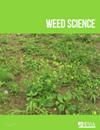Use of Open-Source Object Detection Algorithms to Detect Palmer Amaranth (Amaranthus palmeri) in Soybean
IF 2.1
2区 农林科学
Q2 AGRONOMY
引用次数: 4
Abstract
Abstract Site-specific weed management using open-source object detection algorithms could accurately detect weeds in cropping systems. We investigated the use of object detection algorithms to detect Palmer amaranth (Amaranthus palmeri S. Watson) in soybean [Glycine max (L.) Merr.]. The objectives were to (1) develop an annotated image database of A. palmeri and soybean to fine-tune object detection algorithms, (2) compare effectiveness of multiple open-source algorithms in detecting A. palmeri, and (3) evaluate the relationship between A. palmeri growth features and A. palmeri detection ability. Soybean field sites were established in Manhattan, KS, and Gypsum, KS, with natural populations of A. palmeri. A total of 1,108 and 392 images were taken aerially and at ground level, respectively, between May 27 and July 27, 2021. After image annotation, a total of 4,492 images were selected. Annotated images were used to fine-tune open-source faster regional convolutional (Faster R-CNN) and single-shot detector (SSD) algorithms using a Resnet backbone, as well as the “You Only Look Once” (YOLO) series algorithms. Results demonstrated that YOLO v. 5 achieved the highest mean average precision score of 0.77. For both A. palmeri and soybean detections within this algorithm, the highest F1 score was 0.72 when using a confidence threshold of 0.298. A lower confidence threshold of 0.15 increased the likelihood of species detection, but also increased the likelihood of false-positive detections. The trained YOLOv5 data set was used to identify A. palmeri in a data set paired with measured growth features. Linear regression models predicted that as A. palmeri densities increased and as A. palmeri height increased, precision, recall, and F1 scores of algorithms would decrease. We conclude that open-source algorithms such as YOLOv5 show great potential in detecting A. palmeri in soybean-cropping systems.利用开放源对象检测算法检测大豆中的掌叶苋
基于开源目标检测算法的定点杂草管理可以准确地检测出种植系统中的杂草。本研究利用目标检测算法检测大豆[Glycine max (L.)]中的苋菜(Amaranthus palmeri S. Watson)。稳定)。本研究的目标是:(1)建立棕榈花和大豆的带注释图像数据库,以微调目标检测算法;(2)比较多种开源算法在棕榈花检测中的有效性;(3)评估棕榈花生长特征与棕榈花检测能力之间的关系。在堪萨斯州曼哈顿和堪萨斯州石膏建立了黄豆田基地,并在那里发现了棕榈叶黄豆的天然种群。在2021年5月27日至7月27日期间,在空中和地面分别拍摄了1108和392张图像。经过图像标注后,共选出4492张图像。使用带注释的图像微调开源更快的区域卷积(faster R-CNN)和使用Resnet主干的单镜头检测器(SSD)算法,以及“You Only Look Once”(YOLO)系列算法。结果表明,YOLO v. 5的平均精密度得分最高,为0.77。当置信阈值为0.298时,该算法中棕榈芽孢杆菌和大豆的检测F1得分最高,为0.72。较低的置信阈值为0.15增加了物种检测的可能性,但也增加了假阳性检测的可能性。使用训练好的YOLOv5数据集在与测量的生长特征配对的数据集中识别a . palmeri。线性回归模型预测,随着棕枝密度的增加和棕枝高度的增加,算法的精度、查全率和F1分数均降低。我们认为,YOLOv5等开源算法在大豆种植系统中检测棕榈芽孢杆菌方面具有很大的潜力。
本文章由计算机程序翻译,如有差异,请以英文原文为准。
求助全文
约1分钟内获得全文
求助全文
来源期刊

Weed Science
农林科学-农艺学
CiteScore
4.60
自引率
12.00%
发文量
64
审稿时长
12-24 weeks
期刊介绍:
Weed Science publishes original research and scholarship in the form of peer-reviewed articles focused on fundamental research directly related to all aspects of weed science in agricultural systems. Topics for Weed Science include:
- the biology and ecology of weeds in agricultural, forestry, aquatic, turf, recreational, rights-of-way and other settings, genetics of weeds
- herbicide resistance, chemistry, biochemistry, physiology and molecular action of herbicides and plant growth regulators used to manage undesirable vegetation
- ecology of cropping and other agricultural systems as they relate to weed management
- biological and ecological aspects of weed control tools including biological agents, and herbicide resistant crops
- effect of weed management on soil, air and water.
 求助内容:
求助内容: 应助结果提醒方式:
应助结果提醒方式:


